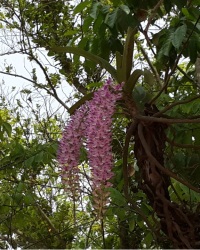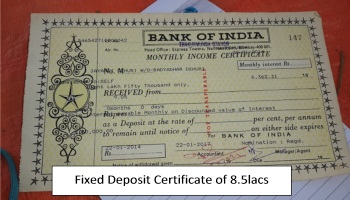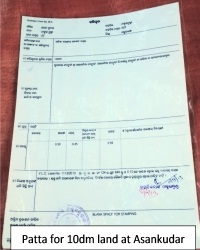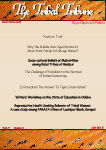Is Relocation the Answer to Tiger Conservation?
| Puspanjali Satpathy | |
| Sikhya Babu |
As the wide highways bustling with vehicles of all sizes give way to undulating narrow roads, one cannot help but admire the girt of nature and men. The Sal forests, braving the unrelenting heat have still maintained their green. The orchids have bloomed displaying an array of colors, their lives clinging to the Sal trees. If you probe a little deeper into the region, you will notice the uncanny resemble of these images and the lives of the tribal groups residing in and around Simlipal Tiger Reserve. The Mayurbhanj district has been home to both tigers and humans for almost the same period of time. The people have battled all odds to call the forests their own. The forests have also provided them with enough to sustain themselves over all these years.
| The changing times have however not favoured this harmonious relationship. The talks of man-animal conflict, pressure on forest resources, lack of health care and education have only grown louder in the recent years. The government has been gradually relocating villages from the core areas for many years now. The PVGTs like Khadias of Kabatkhai and Jamuna have been relocated to Banbasa in the early nineties. The Khols of Jenabil have been shifted in 2010 and the latest relocation has been of the Khadias of Upper Barakhemunda and Bahaghara to Asankudar in December 2013. Much similar relocation has taken place in these years involving mostly the Khadias. It has been twenty years since the first relocation and a lot is still left to desire in the manner in which the people have been moved out. |
|
Around 1994, the Khadias of Jenabil and Kabatkhai were moved to Banbasa located near the host village of Kapanda. The people were relocated to Banbasa with absolutely no amenities in place. They were given meager compensation of Rs. 6000 and the site of relocation had no accessible forests in the vicinity. The new settlement offered no livelihood opportunities for them which forced the people to seek the forests back. Some of the people moved back to a village named Barigaon which was somewhat closer to core forest. The forest department filed a case against the people for this and the people lost all their compensation money to fight their cases in the court. Even in the present day the condition of Banbasa remains deplorable. The only improvement has been the one-room houses which have been built by the government. The MNREGA works sometimes provide livelihood options for the people otherwise they move to the forest for few days every now and then to collect forest produce to sustain themselves. It is unfortunate that the communities which have a government’s development authority, the Khadia Mankdia Development Authority, dedicated for their empowerment are leading such appalling lives. The even more unfortunate part is that the government learnt little from Banbasa experience while displacing the 61 Khols families of Jenabil in 2010. The forest dwelling people were relocated into tin roof houses in the peak summers. Again there were no livelihood options provided in the new location. The rights of the people were also not recognised under FRA before the relocation in violation of both the FRA and the amended Wildlife Protection Act. However this time the people were given the option of choosing from Option 1 or Option 2 of NTCA which is either lump sum compensation of 10lacs or agricultural land or other basic infrastructure. Around 40 families opted for the monetary compensation while the rest took the land; both the options exposing the tribal to exploitation by Dalals and crooks of the vicinity. Some of the settlers have been eventually forced to buy highly overpriced agricultural lands to sustain their livelihoods.
|
|
|
|
 |
The government, given its history of imperfect relocation policies and practices, had a very difficult task during the relocation of Khadias of Upper Barakhemunda and Bahaghara. The host village of Asankudar has been chosen as the settlement for the 34 Khadia families.Asankudar is a village located at a distance of 12-14 kilometers from block head quarter Thakurmunda. The families have been given 10 dm each of homestead land and compensation of 10 lacs. Of the money allocated for compensation, the people are meant to utilize close to 1.5lacs as relocation expenses. The remaining 8.5 lacs have been fixed deposited in the Thakurmunda branch Bank of India. The monthly interest accumulated from this lump sum value is around 6000 rupees, which is used by people for day today expenses. Their livelihood depended completely on forest produce like honey, Lac, Palua etc.; they have had no dependence on agriculture. The Asankudar village is located on the periphery of the forest; the male members of the villages often go to the forests to collect some minor forest produce. However they do not venture far into the forest and generally return by night; therefore the collection of produce is not much. The traditional livelihood produces like Lac, honey and Palua have drastically reduced after relocation so the people are forced to shift to new options like Sal leaf plates. The women are learning to make Sal Leaf plates from the host village’s womenfolk. The women were saying if they get Palua bulbs (seeds) then they were keen to farm them even in Asankudar. They also mentioned that currently they have no access to core forest even to collect the bulbs of Palua. The government has initiated a Minimum Support Price scheme for 10 Minor Forest Produce including honey, sal leaves etc. which guarantees a base price below which they should not be sold. However the people have no awareness of this scheme and are under selling the little produce they collect like honey. In fact the host village is also not aware of MSP guidelines and is selling Sal Leaf plates at almost half the minimum support price. The womenfolk have formulated two SHGs for which they contribute 20 Rupees every fortnight. When asked what they plan to do with the money so collected, they had vague responses. It remains to be seen how useful these SHGs will be for enhancement of livelihoods.
The people have been relocated to this region in December 2013. The government has recognised individual rights for the homestead lands of these families at Upper Barakhemunda and Bahaghara under FRA. Most of the families have been given rights to 4dm of land. Given that rights under the FRA need to be recognized on land under occupation, it is unclear how every family has been given title to exactly the same area of land. However in response to our question towards the awareness of people on Forest Rights Act they said, “We were always told we have no rights over the forest.” It does not quite make sense how the people have not been informed of FRA and yet their rights have been recognized without following the due process despite section 4(5) of FRA which states that:
“Save as otherwise provided, no member of the forest dwelling Scheduled Tribe or other traditional forest dweller shall be evicted or removed from the forest land under his occupation till the recognition and the verification procedure is complete”
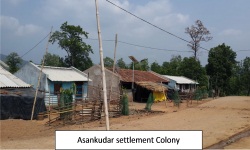 |
The government has built one room houses under Mo Kudia scheme for the people almost after 8 months since the relocation. Each of the families has been given homestead land of 10 dm on which the house stands. The government had chosen two locations of Thakurmunda block for relocation: one near the host village of Hatiguda and other near Asankudar. The guiding criteria for selection were availability of homestead land, proximity to schools and healthcare facilities and other basic amenities. |
| The people have chosen Asankudar as it was relatively closer to the forest. The relocated families have been almost completely illiterate.The schools were located far from Bahaghara and Upper Barakhemunda and the children of these communities had never been to school. After relocation to Asankudar the children who were of school going age were identified and in the first year 12 children were enrolled in the neighboring schools at Hatiguda and Angarapadar residential school. In the current academic year 8 more children have been enrolled in these two schools.The Anganbadi center has been opened for the younger children. Some of the children of the host village also attend this Anganbadi. The building for the Anganbadi center is under construction. | |
| The Asankudar village does not have any excess agricultural land which could be given to the new settlers for farming. In the previous year, some of the families have worked on the agricultural land of the host villagers as share croppers (BhagaChasi.) The people were provided with basic training and seeds by the government. The people have had to learn the basics of farming from a scratch as they had no dependence on agriculture in the past. Despite the odds, the harvest has been good enough to encourage the people to take up agriculture as | 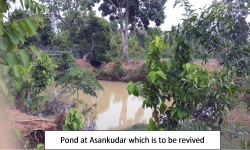 |
| a livelihood option. They have pinned their hopes on the government’s promise of providing them with agricultural land in the vicinity. The irrigation is dependent on the canal which passes beside the village; however in the summers the water is not sufficient even for bathing and cleaning purposes. There is a proposal to revive the ponds of the village. The excavation and retaining works for the pond are underway and this could go a long way to solve the water woes of the village. | |
During the visit we met with the BDO of Thakurmunda who had many interesting insights to share regarding the ground realities of the region. The FRA has been implemented to some extent in the region. Of the 154 villages which fall under Thakurmunda block, CFR is in process for 148 villages. The remaining 6 villages are either uninhabited (4 no.) or there are disputes in CFR claims (2 nos.) The individual claim for 128 persons has been recognised. The BDO explained that there is relatively low number of IFRs because there lands are currently classified as revenue lands and no longer as forest lands. Many of these lands were classified as forests under Sabik settlement and subsequently reclassified as Revenue Land under Hal settlement. The BDO is of the view that the rights of these lands should be settled under OGLS instead of FRA. We mentioned the circular by Revenue Secy which clarifies this issue and clearly mentions that the recognition of rights can also be done under FRA.We asked the BDO if the CFR has been claimed as per traditional boundaries or through the VSS boundaries. He said that traditional boundaries have been identified with the help of locals.In the CFR claim form they are attaching these hand drawn maps. In the meanwhile, with Vasundhara’s help they are using GPS techniques for proper demarcation and creation of maps. The BDO has ensured that the CFR rights process shall be speeded up.
 |
The current trend by the government is to set target based goals at all levels of administration for the implementation of government schemes and policies. The ground realities at many places may not be conducive to that scheme, but the government has little concern for these matters. There is added pressure on the district administration to achieve targets which has adverse impact on the overall social welfare. The IndraAwas scheme of the government allots a sum of 75,000 Rupees for building houses. The current rates for Masons and materials, even in the villages, have inflated to such an extent that 75,000 Rupees is not reasonable to build a house. In many villages we see semi constructed abandoned houses which clearly do not fulfill the intentions of the scheme. Similarly the schemes for building toilets in villages, though noble, are often not successful due to lack of water supply to these places. There are crores of rupees which are allotted to these programs and the government could go a long way if feasibility analysis studies are done instead of following the blanket implementation strategy. The Khadias are not known for doing laborious activities; the relocation has however forced them into agriculture and NMREGA works which are physically strenuous. It remains to be seen how viable these livelihood means are for them in the long run. The BDO of Thakurmunda touched upon these issues and added that his administration is doing the best they can. |
| The people were relocated during the winter of 2013 in the month of December. They were promised pukka houses with basic facilities will be ready before they had to shift. Instead when they arrived there was nothing except a few tarpaulin sheets to be used as temporary houses. The people had to make do in these arrangements for over 7-8 months. The government paid no heed to their umpteen pleas for houses. The people also went to the then collector regarding this matter. It was only after the monsoon waters and people’s patience reached the roof that | 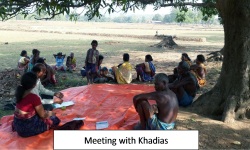 |
| the one roomed houses were constructed. The people depend on only one narrow stream of canal water which dries up in the summers. The government has dug two bore-wells which is the primary source for drinking water. The pond is also half constructed and thus is unable to be of any use.The government has provided solar enabled street lights. The host village has electricity connection; the government must extend the supply of electricity to these families as well. The people said they were forced out of their houses in Bahaghara and Upper Barakhemunda through the use of threat and deceit when the law only permits voluntary relocation and only after it has been proved that co-existance is not possible. In the words of the people, “The government wanted us to move out of the forest before anyone had the slightest chance to convince us otherwise. They wanted us to move out in one week’s time!” | |
The women had just got the year’s produce of Palua and were still to process it. After a lot of convincing the government agreed to give them 15 days’ time. The trucks transported the luggage of 2 families each which meant that the people were not allowed to carry their entire belongings.In the initial one month the people were provided with food by the administration. After the end of the month, the people had to fend for themselves taking some help from the host village. It has been 18 months since the relocation and the promise of agricultural land has not yet been kept. The people have faith in the administration and maintain that since the government has assured them of land they will get it. However during our discussions with the government officials it was clear that they have not found any suitable patch of land which can be provided to the people.
The Khadias are a fun loving community. They have found happiness in the little things of life. After talking with us for little over an hour, SunaPhula, one of the outgoing Khadias invited us to the PunaiParab! The people have fond memories of SarojrajChoudhry. The houses they lived in at Upper Barakhemunda and Bahaghara were built during his time in the office. They remember him for taking care to protect their village from elephants by building trenches. The people had lived in the lap of nature for so long and have rich knowledge of wildlife and biodiversity. They said of the many problems they face in the new village is that of the heat; “We used to live by the same stream the elephants drank water in. Our houses in the village never felt so hot even in the peak of summers.” Despite their troubles, they are trying to see the positives of the relocation in the form of better education for their children. When asked what benefits of education can bring, they replied, “The government has told education leads to jobs” and “Our children would be able to read the signage on the road!” Education can truly bring about many positive changes in the lives of these people and make them less vulnerable to exploitation although it needs to be sensitive to their culture and identity.
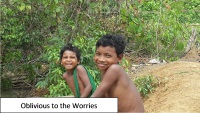
The resettlement of Khadias at Asankudar is projected by the government as a model relocation. The minimum facilities provided to the people are definitely an improvement from the past. However the government must learn to treat the tribal groups in a just manner. Section 38 (V) 4 of Wildlife (Protection) Amendment Act 2006 states:
“Subject to the provisions contained in this Act, the State government shall while preparing a Tiger Conservation Plan, ensure the agricultural, livelihood, developmental and other interests of the people living in tiger bearing forests or a tiger reserve.”
“No resettlement shall take place until facilities and land allocation at the resettlement location is complete as per the promised package”
The people were not given the options as mentioned in the NTCA guidelines; instead they were given the 10lac compensation package only. The government must have at least the courtesy to informing people of their rights instead of simply imposing schemes which they feel are applicable and right. The PVTG groups are identified as particularly vulnerable; therefore it goes without saying that the government must be extra cautious to prevent any sort of exploitation and protecting their unique cultural traits. Despite no scientific studies or proof of any kind, the major concern expressed by the government was that the presence of human settlement near the tigers was the primary reason for tiger poaching and disturbance to habitat of tigers. The nexus of poachers is so huge that it goes beyond the presence/absence of tribal and the forest department has failed to curb poaching in all these years. What strikes as odd is the fact that the only regions of the country where we still find tigers in the wild are predominantly tribal belts! Somewhere in the scheme of development, this irony is lost to many.
Vasundhara, Bhubaneswar, Odisha

